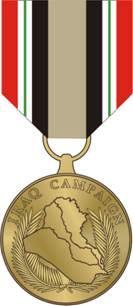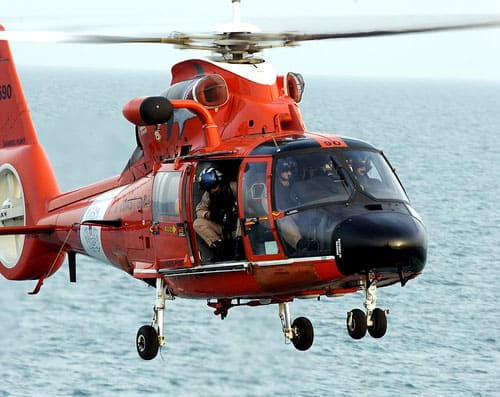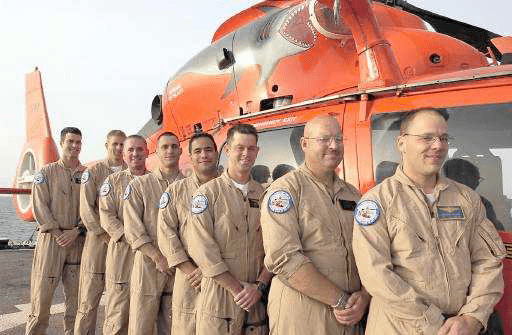n late 2002, at the request of the Department of Defense, the Coast Guard began preparations for mission specific duties in support of military operations in and around Iraq. The Coast Guard sent two 378 foot WHEC cutters with aviation detachments, a sea-going buoy tender, eight 110 foot patrol boats, Port Security Units, Tactical Law Enforcement Teams and support staff.
The Coast Guard performed many missions but the primary ones were its traditional missions of maritime interdiction, search, port security, and maintenance of aids to navigation. In performing these missions, Coast Guard units were often closer to the area of conflict than other naval units.
Mediterranean
 The Coast Guard Cutter Dallas WHEC 716 departed Charleston on February 8 with an HH-65 aviation detachment from Group Atlantic City on board. The mission was to participate with the Sixth Fleet in the Mediterranean during Operation Enduring Freedom and Operation Iraqi Freedom. The first task was to escort shipping through the Strait of Gibraltar as there was concern that Al Quida or other militant terrorists might attack shipping in the strait. NATO ships took over escort duties in the Strait in mid-March and the Dallas was assigned to patrol further east in the Mediterranean. As hostilities with Iraq commenced the Dallas began working closely with USS Truman/USS Roosevelt carrier strike groups. The Dallas acted as plane guard for carrier flight operations and for the first three days of the war was the only ship providing security as assigned escort vessels were dispatched through the Suez Canal to better position them for launching their Tomahawk missiles.
The Coast Guard Cutter Dallas WHEC 716 departed Charleston on February 8 with an HH-65 aviation detachment from Group Atlantic City on board. The mission was to participate with the Sixth Fleet in the Mediterranean during Operation Enduring Freedom and Operation Iraqi Freedom. The first task was to escort shipping through the Strait of Gibraltar as there was concern that Al Quida or other militant terrorists might attack shipping in the strait. NATO ships took over escort duties in the Strait in mid-March and the Dallas was assigned to patrol further east in the Mediterranean. As hostilities with Iraq commenced the Dallas began working closely with USS Truman/USS Roosevelt carrier strike groups. The Dallas acted as plane guard for carrier flight operations and for the first three days of the war was the only ship providing security as assigned escort vessels were dispatched through the Suez Canal to better position them for launching their Tomahawk missiles.
Four of the eight patrol boats, Bainbridge Island, Grand Isle, Knight Island, Pea Island, were based at Souda Bay, Crete and had been providing escort protection to ships coming in and out of the conflict zone. When hostilities ended, the Dallas joined by the patrol boats, conducted interdiction operations off the coast of Syria to intercept any fleeing Iraqi leaders or the attempted transport of banned weapons. Dallas was called the “Lead Dog” and her helicopter flew “Watchdog” missions daily checking out all vessels, photographing them, and reporting the information to intelligence staff members who then, when deemed appropriate, directed one of the ships to send over a boarding party. Rear Admiral John Stufflebeem said the operation was interdiction; that it is the Coast Guard’s bailiwick and they are good at it.
The Dallas and the four Mediterranean patrol boats returned to the United States on June 11.
Arabian Gulf
Units deployed to the Arabian Gulf were the 378 foot WHEC Boutwell, the buoy tender Walnut, four 110 foot WPG Patrol Boats, Wranggle, Adak, Aqudineck, Baranof, Port Security Units and LEDETS. The 110 Ft patrol boats were placed in cradles and transported by cargo ship. Their Crews were flown in by air. The Port security unit’s equipment and personnel were flown in.
The principle reason for The Walnut’s deployment was the possibility of Iraqi oil releases similar to what occurred at the end of the Gulf War. Walnut had on board equipment to contain oil spills. Fortunately this capability was not needed. When the war began the Walnut joined the other Coast Guard units conducting interdiction operations. The Walnut’s 40,000 pound capacity boom also supported the Coast Guard Port Security Units on the Gulf Oil Platforms as they performed their security mission. The Walnut’s major contribution to Operation Iraqi Freedom was the establishment of aids to navigation in the Kohr abd Allah waterway. The Walnut was the first to transit the waterway and enter Umm Qasr. She then spent the next three weeks using Iraqi buoys to mark the channel into Umm Qasr opening up the port to shipping.

The Boutwell had a fairly normal transition to deployment. The Coast Guard had regularly deployed a major cutter to the Arabian Gulf in the years since1991. She had been scheduled for deployment in 2003 but deployment occurred earlier than planned. The Boutwell picked up her aviation detachment from the Air Station at Barbers Point in Hawaii and deployed with the Tarawa amphibious ready group. The HH-65 helicopter was specially equipped for the deployment with forward looking infrared (FLIR) which greatly increased its utility. In February the Boutwell arrived in the gulf and became part of the Constellation battle group.
The initial mission was to support the enforcement of United Nations sanctions and prevent smuggling of illegal oil and goods. This directly paralleled Coast Guard drug and migrant interdiction and the transition proved to be seamless. Boutwell also worked in close providing security and in addition supported the patrol boats by providing fuel, and other supplies that had been flown out to them. This allowed the patrol boats to remain at sea longer without having to return to the Kuwait Naval Base or Bahrain. The Boutwell also made extensive use of her helicopter.
The most useful pieces of equipment on board the helicopter were the traffic alert and avoidance system (TCAS) and the FLIR. The FLIR allowed the helicopter to identify vessels while maintaining a safe standoff distance during patrols during both day and night operations. The workload was compounded by operating in a high density air traffic control zone while not crossing the “black line” that separated the helicopter from Iranian territorial waters. Near this line were the two large oil platforms secured by a Coast Guard security unit. The HH-65 provided surveillance support. Iranian gunships threatened to shoot them down on three occasions but each time the Brits in heavily armed Lynx helicopters convinced the Iranians that it would not be a good idea. Needless to say there was a special feeling for the Brits.
Another major mission was to provide aerial escort for ships moving up and down the Khwar Abd Allah River. Coast Guard patrol boats were assigned to the front and end of the convoy of ships. The job of the HH-65 was to ensure there were no mines, vessels, swimmers, or anything else that could cause a problem.
There was only one small bright orange helicopter in all of Iraq. LCDR Greg Fuller, one of the HH-65 pilots, said that everyone was a little surprised and baffled when they saw it. However, less restrictive operational limits, smaller size and mission flexibility made the HH-65 an asset of choice for many unique missions. Medivacs, logistic runs, VIP transport, moving mail and the ability to fly at night, gave the crew the opportunity to land on 23 different coalition warships as well as in and out of Iraq. Expecting extensive use the HH65 crew was augmented and consisted of three pilots, a rescue swimmer and four maintenance technicians. The helicopter flew 188 missions of which 91 were combat flights. In keeping with Coastie humor, when requested to come up with a tactical call sign they chose “Jaws 90” for the little orange machine and painted a shark on each side with the mouth open at the engine intake.

Before the war began the patrol boats performed boardings in support of UN sanctions. They continued this after the war began but the emphasis was searching for arms, providing security for the Gulf Oil Platforms when sea conditions prohibited operation of the PSU small craft and security escorts for vessels going up the channel to Umm Qsar. They did find arms and also intercepted a tug carrying mines. The Coast Guards ability to operate in the littorals was an important asset. The cutter Boutwell and the WPBs were the only ships that could easily operate in the north end of Northern Arabian Gulf.
The Port Security Units were assigned to Gulf Oil Platform security mission; they supplemented naval security units at the Kuwait Naval Base and Ash Shuaybah; and provided security for the port of Umm Qasr.
The Boutwell and Walnut departed the area in mid-May and the crews of the patrol boats were rotated out and new crews flown in. As of July 2004 the cutters Momomoy and Maui had joined the original four patrol boats. The number of PSU people had been reduced. PSU 307 and tactical Law enforcement Team South were also assigned. The cutter Monroe WHEC 724 was deployed to the Gulf in 2004 joining the Naval Expeditionary Strike Force and the cutter Midgett WHEC 726 was deployed to a similar assignment in 2006. Both cutters had an aviation detachment on board.
In 2008 CAPT Matthew Bell took command of Coast Guard Patrol Forces Southwest Asia assuming tactical control of six Coast Guard patrol boats, five Navy patrol Boats, a large support unit in Bahrain, a training team in Umm Qsar Iraq, and a Coast Guard forward operating base aboard the Kuwait Naval Base.
